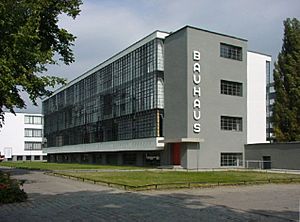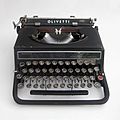Bauhaus facts for kids

The Bauhaus was a design school that operated from 1919 to 1933 in Germany. It is widely regarded as the most influential art school of the 20th century. It promoted modernism. It is most well known for teaching painting, photography, advertising, weaving, architecture and the design of furniture and household products. The work that it produced and its teaching methods had a world-wide influence on art, design, photography, architecture and art education.
It was formally called the "Staatliches Bauhaus" from 1919 to 1932 because it was state funded in that period. From 1919 to 1925 it was in Weimar, in the state of Thuringia and from 1926 to 1932 it was in Dessau, in the state of Sachsen-Anhalt. It operated as privately funded school in Berlin from the end of 1932 until April 1933.
Its staff included some of the most famous artists and architects of the 20th century, including: Walter Gropius, who founded the school, Ludwig Mies van der Rohe, Wassily Kandinsky, Lyonel Feininger, Paul Klee, László Moholy-Nagy, Marcel Breuer, Josef Albers, Anni Albers, Oskar Schlemmer and Hannes Meyer.
Its former buildings in Weimar and Dessau were jointly made a UNESCO World Heritage Site in 1996.
Images for kids
-
Typography by Herbert Bayer above the entrance to the workshop block of the Bauhaus Dessau, 2005
-
Bauhaus founder Walter Gropius (1883–1969)
-
The main building of the Bauhaus-University Weimar. Built between 1904 and 1911 and designed by Henry van de Velde to house the sculptors' studio at the Grand Ducal Saxon Art School, it was designated a UNESCO World Heritage Site in 1996.
-
Wassily Chairs by Marcel Breuer (1925–1926)
-
An Olivetti Studio 42 typewriter, designed by Bauhausler Xanti Schawinsky in 1936
-
A Bauhaus-style building with "thermometer" windows on Pines Street in Tel Aviv
See also
 In Spanish: Escuela de la Bauhaus para niños
In Spanish: Escuela de la Bauhaus para niños











